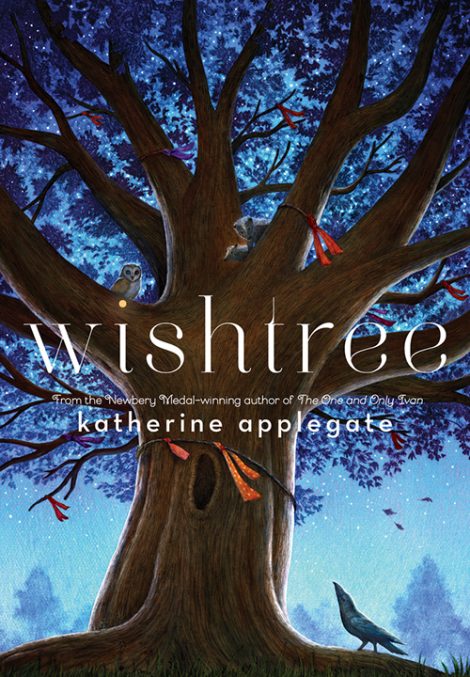
WISHTREE
Red is an oak tree who is many rings old. Red is the neighborhood “wishtree”—people write their wishes on pieces of cloth and tie them to Red’s branches. Along with her crow friend Bongo and other animals who seek refuge in Red’s hollows, this “wishtree” watches over the neighborhood.
You might say Red has seen it all. Until a new family moves in. Not everyone is welcoming, and Red’s experiences as a wishtree are more important than ever.
Funny, deep, warm, and nuanced, Wishtree is Newbery Medalist and New York Times–bestselling author Katherine Applegate at her very best—writing from the heart,
Red is an oak tree who is many rings old. Red is the neighborhood “wishtree”—people write their wishes on pieces of cloth and tie them to Red’s branches. Along with her crow friend Bongo and other animals who seek refuge in Red’s hollows, this “wishtree” watches over the neighborhood.
You might say Red has seen it all. Until a new family moves in. Not everyone is welcoming, and Red’s experiences as a wishtree are more important than ever.
Funny, deep, warm, and nuanced, Wishtree is Newbery Medalist and New York Times–bestselling author Katherine Applegate at her very best—writing from the heart, and from a completely unexpected point of view.
- Feiwel & Friends
- Hardcover
- September 2017
- 224 Pages
- 9781250043221
About Katherine Applegate
 Katherine Applegate is the author of The One and Only Ivan, winner of the Newbery Medal. Her novel Crenshaw, spent over twenty weeks on the New York Times children’s bestseller list, and her first middle-grade stand-alone novel, Home of the Brave continues to be included on state reading lists, summer reading lists, and class reading lists. Katherine Applegate lives in Tiburon, California, with her family.
Katherine Applegate is the author of The One and Only Ivan, winner of the Newbery Medal. Her novel Crenshaw, spent over twenty weeks on the New York Times children’s bestseller list, and her first middle-grade stand-alone novel, Home of the Brave continues to be included on state reading lists, summer reading lists, and class reading lists. Katherine Applegate lives in Tiburon, California, with her family.
Praise
“A beautifully written, morally bracing story that will leave its imprint on a reader of any age.”—The New York Times
“A touching display of community support and shared history.”—The Washington Post
“Timely, necessary, and brimming with heart.”—Booklist, starred review
“A distinctive call for kindness, delivered by an unforgettable narrator.”—Publishers Weekly, starred review
Discussion Questions
1. Discuss Red’s comment: “Making others feel safe is a fine way to spend your days” (p. 26). How does the tree make others feel safe? Is this statement referring only to the animal inhabitants of the tree? What does this comment tell you about the personality of the tree?
2. Why do the animals feel comfortable with Samar? Why does Bongo give her gifts? What qualities of her nature make the animals trust her? Why do these qualities make it harder for her to make friends with other children?
3. Red compares the neighborhood to a garden, “wild and tangled and colorful” (p. 54). Why does the tree compare the people in the area to a garden? Why is the neighborhood not welcoming to Samar’s family?
4. Describe the boy who carves a word in the tree. What does the author tell you about him and what assumptions can you make about his character? Why do you think he would carve that word into the tree? How does this act affect Red, Bongo, Samar, and her family? What effect does the carving have on Francesca? What are the feelings of the police who come to investigate?
5. Why does Francesca want to cut the tree down? What do the police officers, Max and Sandy, think about her reasons? Discuss Max’s wish and what it means (p. 74).
6. Discuss Red’s description—“standing tall, reaching deep”—as it applies to the tree and as it applies to Samar (p. 71). What personality traits do the tree and Samar have in common? How do those traits help them both cope with the changes in their lives?
7. Discuss Red’s question, “How does friendship happen?” (p. 82). What is Bongo’s answer? Why do you think Red and Bongo are friends? What makes them special to each other? What qualities do you look for in a friend? Why is it hard for Samar and Stephen to become friends?
8. Why does Red decide to speak to the children? How does this act change their relationship to the tree and to each other? Why will the tree not speak to Francesca?
9. How does Stephen help to make a difference in the neighborhood on Wishing Day? What is the message the children in the school deliver with their wishes? What makes Francesca change her mind about cutting down the tree?
10. Discuss Red’s statement: “I wanted to make a difference, just a little difference, before I left this lovely world” (p. 126). What difference does Red make by talking to Stephen and Samar? Discuss Stephen’s comment: “My parents aren’t bad people. They’re just . . . afraid of things” (p. 125). What do you think you can do to make a difference in this world?
Excerpt
1
It’s hard to talk to trees. We’re not big on chitchat.
That’s not to say we can’t do amazing things, things you’ll probably never do.
Cradle downy owlets. Steady flimsy tree forts. Photosynthesize.
But talk to people? Not so much.
And just try to get a tree to tell a good joke.
Trees do talk to some folks, the ones we know we can trust. We talk to daredevil squirrels. We talk to hardworking worms. We talk to flashy butterflies and bashful moths.
Birds? They’re delightful. Frogs? Grumpy, but good-hearted. Snakes? Terrible gossips.
Trees? Never met a tree I didn’t like.
Well, okay. There’s that sycamore down at the corner. Yakkity-yakkity-yak, that one.
So do we ever talk to people? Actually talk, that most people-y of people skills?
Good question.
Trees have a rather complicated relationship with people, after all. One minute you’re hugging us. The next minute you’re turning us into tables and tongue depressors.
Perhaps you’re wondering why the fact that trees talk wasn’t covered in science class, during those Mother Nature Is Our Friend lessons.
Don’t blame your teachers. They probably don’t know that trees can talk. Most people don’t.
Nonetheless, if you find yourself standing near a particularly friendly-looking tree on a particularly lucky-feeling day, it can’t hurt to listen up.
Trees can’t tell jokes.
But we can certainly tell stories.
And if all you hear is the whisper of leaves, don’t worry. Most trees are introverts at heart.
2
Name’s Red, by the way.
Maybe we’ve met? Oak tree near the elementary school? Big, but not too? Sweet shade in the summer, fine color in the fall?
I am proud to say that I’m a northern red oak, also known as Quercus rubra. Red oaks are one of the most common trees in North America. In my neighborhood alone, hundreds upon hundreds of us are weaving our roots into the soil like knitters on a mission.
I have ridged, reddish-gray bark; leathery leaves with pointed lobes; stubborn, searching roots; and, if I do say so myself, the best fall color on the street. “Red” doesn’t begin to do me justice. Come October, I look like I’m ablaze. It’s a miracle the fire department doesn’t try to hose me down every autumn.
You might be surprised to learn that all red oaks are named Red.
Likewise, all sugar maples are called Sugar. All junipers are called Juniper. And all boojum trees are called Boojum.
That’s how it is in tree world. We don’t need names to tell one another apart.
Imagine a classroom where every child is named Melvin. Imagine the poor teacher trying to take attendance each morning.
It’s a good thing trees don’t go to school.
Of course, there are exceptions to the name rule. Somewhere in Los Angeles there’s a palm tree who insists on being called Karma, but you know how Californians can be.
Text copyright © 2017 by Katherine Applegate
Illustrations copyright © 2017 by Charles Santoso
